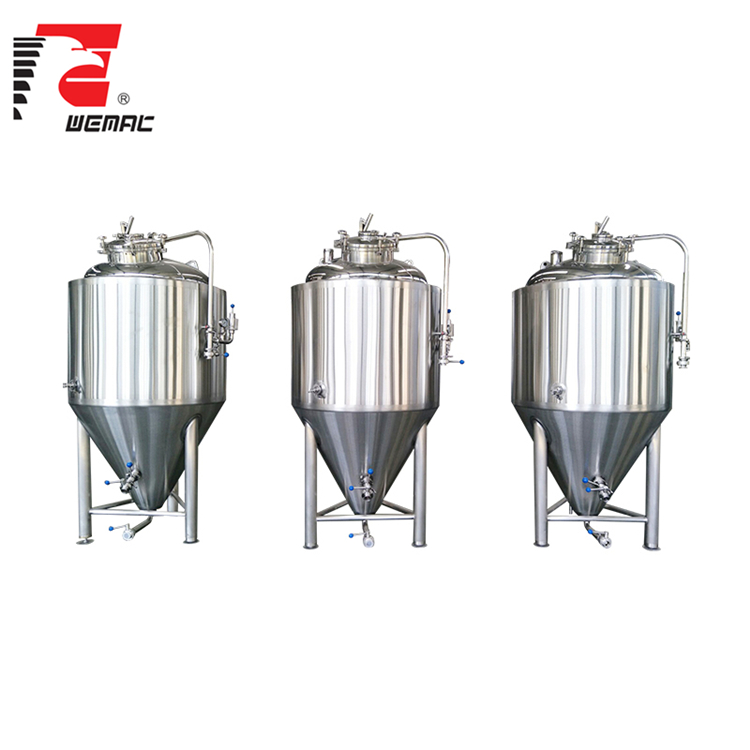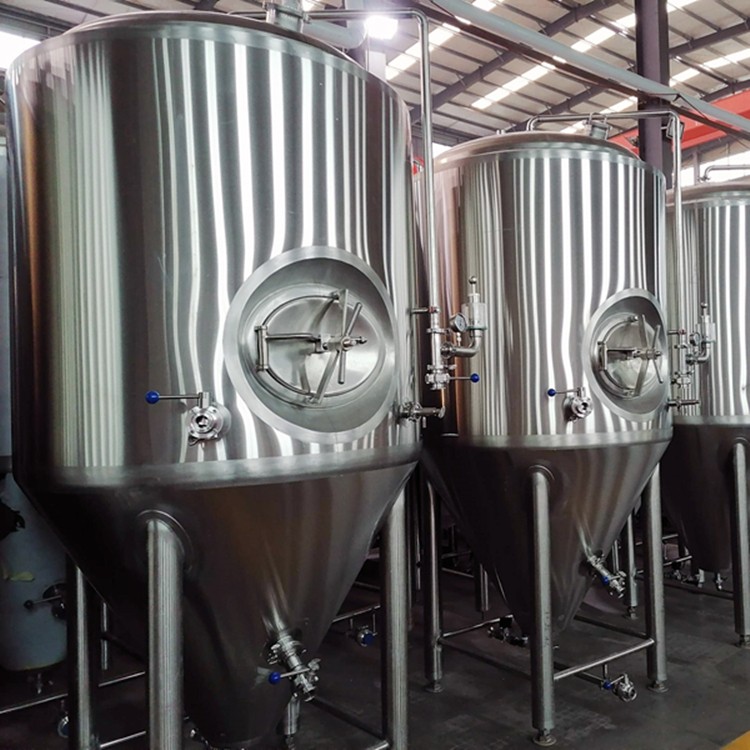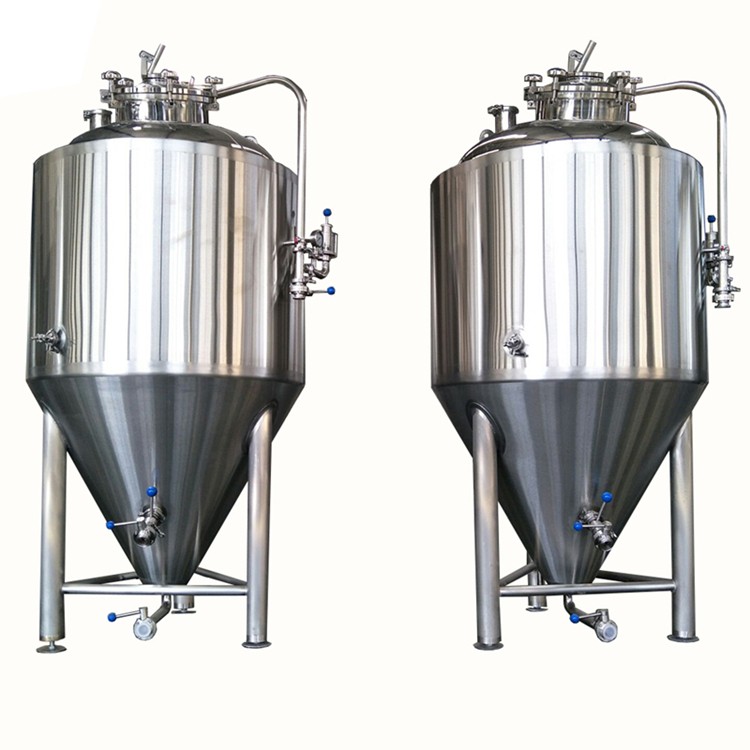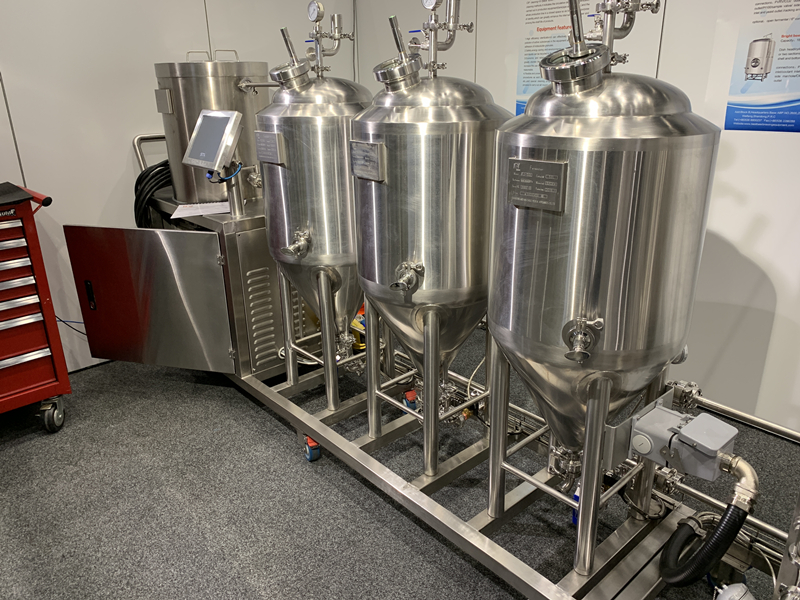
Beer fermentation and fermentation tank ZXF
- * Processing : Fermenting Equipment, Beer Brewing
- * Brand : WEMAC
- * Condition : New
- * Material : SUS 304 316
- * Place of Origin : Weifang, China (Mainland)
- * Control system : AUTO/MANUAL
- * Warranty : Within 24 months against the date of B/L
- * Voltage: : To Be Determined (220V/ 380V/ 415V)
Beer fermentation and fermentation tank
The art and science of brewing beer involve a fascinating process known as fermentation. This transformative stage is where the magic happens, converting sugars into alcohol and creating the distinctive flavors and aromas that beer enthusiasts savor.
The brewing process of craft beer basically has two important core steps: one is malt saccharification, and the other is wort fermentation. Among them, the wort fermentation process is mainly completed by fermentation tanks. For beer wort fermentation, beer fermentation tanks, configuration of fermentation tanks, fermentation processes, fermentation control and other related information, please continue to look down.

1. The basic principles of craft beer fermentation and fermentation tanks
In the beer brewing process, the malt passes through the saccharification system to prepare the wort, which is cooled, enters the fermentation tank, adds the brewer's yeast, and starts the fermentation. The traditional process is divided into pre-fermentation and post-fermentation, which are carried out in different fermentation tanks. The current popular method is to carry out one fermentation in one tank. The pre-fermentation mainly uses yeast to convert the maltose in the wort into alcohol (that is, the anaerobic respiration of yeast), and the post-fermentation mainly produces some flavor substances, removes the peculiar smell in the beer, and promotes the maturation of the beer.
Cool, enter the fermentation tank, add brewer's yeast, and start fermentation. The traditional process is divided into pre-fermentation and post-fermentation, which are carried out in different fermentation tanks. The current popular method is to carry out one fermentation in one tank. The pre-fermentation mainly uses yeast to convert the maltose in the wort into alcohol (that is, the anaerobic respiration of yeast), and the post-fermentation mainly produces some flavor substances, removes the peculiar smell in the beer, and promotes the maturation of the beer.
2.Characteristics of beer fermentation and fermentation tanks
1. It should have a tight structure.
2. Good liquid mixing characteristics.
3. Good heat transfer rate of mass transfer phase.
4. It has matching and reliable detection and control instruments.
5. High reliability of fermentation process operation.
3. Configuration instructions of beer fermentation tank
1. The volume of beer fermentation tank is determined according to the customer's requirements; it is generally divided into two parameters, effective volume and total volume, because beer fermentation requires a certain amount of fermentation tank space, and the total volume is generally 1.2-1.3 times the effective volume.
2. The overall dimensions of beer fermentation tanks are generally designed flexibly according to the customer's site, but the basic height-to-diameter ratio is not less than 1.
3. The material of beer fermentation tank is mainly food-grade SUS304 stainless steel. SUS316L can also be used if the customer requires it, but the cost is much higher.
4. The polishing accuracy of the inner wall of the beer fermentation tank is not more than 0.6um.
5. The beer fermentation tank needs heat preservation. Generally, polyurethane is used as the heat preservation material.
6. Beer fermentation tanks are generally designed with lower cones, and they are usually designed with 60° and 72° taper pressure resistance.
7. Cooling method of beer fermentation tank: mainly use stainless steel Maitreya plate or hose jacket to cool down. The cooling medium is generally cooled by ice water circulating at minus 7 degrees.
8. Cleaning of beer fermentation tank: Mainly equipped with cleaning device, cyclic cleaning with water, alkaline water or disinfectant.
9. The beer fermentation tank is equipped with a top pressure manhole or a waist pressure manhole, which is convenient for observation or manual cleaning in the tank.
10. The temperature control of the beer fermentation tank mainly adopts PT100 temperature probe detection, and the solenoid valve controls the flow of ice water for automatic control.
11. The pressure control of beer fermentation tank mainly adopts mechanical pressure regulating valve to automatically control, and the pressure gauge shows.
12. Other pipe fittings and valves, such as sampling valve, butterfly valve, ice water valve, hops, etc., shall be prepared according to process requirements.

4.Description of the role of beer fermentation tank accessories
1. Wine receiving valve: If the wine is sold directly in the fermentation tank, it is recommended to configure a wine receiving valve, which can facilitate wine receiving.
2. Refrigeration system: It can accurately control the beer fermentation temperature, reduce the error of the fermentation temperature, and ensure the quality of beer brewing.
3. Manhole of the fermentation tank: It can add hops, and it is also convenient for everyone to observe the wine level, and it is also convenient for people to enter the tank for manual cleaning of the inside of the tank.
4. Pressure gauge: It is mainly used to display the pressure data of the fermentation tank, so that everyone can observe the pressure in the tank.
5. Fermentation temperature controller: used to adjust the beer fermentation temperature to ensure the stability of the fermentation temperature during the beer fermentation process.
6. Safety valve: The safety guarantee of the beer fermentation process can automatically discharge the pressure to prevent the air pressure from being too high due to operator errors and safety accidents.
7. Sampling valve: It is mainly used for sampling and testing of fermentation liquid during beer fermentation to prevent bacteria contamination during fermentation due to sampling.
8. Level gauge: If it is convenient to observe, you can configure a level gauge to know the quantity of beer in the fermentation tank at any time.

5. Fermentation process of beer fermentation tank
1. Beer fermentation temperature control: Controlling different fermentation temperatures has its own advantages and disadvantages. Using low-temperature fermentation, yeast produces fewer by-products during the fermentation process, which makes beer taste better and foams in good condition, but the fermentation time is long; Using high-temperature fermentation, the fermentation speed of yeast is faster, the fermentation time is short, and the utilization rate of the equipment is high, but there are more by-products and the beer taste is poor.
2. Control of beer concentration: The change of wort concentration is affected by fermentation temperature and fermentation time. If the fermentation is vigorous and the sugar reduction rate is fast, the fermentation temperature can be appropriately lowered and the maximum temperature retention time can be shortened; on the contrary, the fermentation temperature should be appropriately increased or the maximum temperature retention time should be extended.
3. The control of beer fermentation time: The fermentation time mainly depends on the change of fermentation temperature. If the fermentation temperature is high, the fermentation time will be short; if the fermentation temperature is low, the fermentation time will be long.
There are many types of fermentation tanks, as long as they are used in the fermentation industry, because of different uses, their requirements for fermentation tanks are also different. Beer fermentation tanks are also different according to the brewing of different beers. The above mentioned are the general contents of beer fermentation tanks for reference. If you want to learn more about beer fermentation tanks or beer equipment-related knowledge, you can follow the company's website or send an email to tell us what you think.
Item | Production capacity | Volume in US Gallon |
100L | 100L/day | 27 US Gallon |
200L | 200L/day | 54 US Gallon |
300L | 300L/day | 81 US Gallon |
500L | 500L/day | 135 US Gallon |
600L | 600L/day | 162 US Gallon |
800L | 800L/day | 216 US Gallon |
1000L | 1000L/day | 270 US Gallon |
1500L | 1500L/day | 405 US Gallon |
2000L | 2000L/day | 540 US Gallon |
2500L | 2500L/day | 675 US Gallon |
3000L | 3000L/day | 810 US Gallon |
FAQ
1. What is beer fermentation, and why is it crucial in the brewing process?
Beer fermentation is the process where yeast converts sugars into alcohol and carbon dioxide, producing the unique flavors and aromas of beer. It is a critical step in brewing, shaping the beer's character.
2. How long does the beer fermentation process typically take?
The duration of beer fermentation varies depending on the beer style and fermentation conditions. It can range from a few days to several weeks.
3. What is the role of yeast in beer fermentation?
Yeast is the microorganism responsible for fermenting sugars in the wort, producing alcohol and carbon dioxide. Different yeast strains contribute distinct flavors and aromas to the beer.
4. Why are fermentation tanks important in the brewing process?
Fermentation tanks provide a controlled environment for the fermentation process. They allow brewers to manage temperature, pressure, and yeast activity, influencing the beer's quality and characteristics.
5. What materials are commonly used to make fermentation tanks?
Stainless steel is a popular choice for fermentation tanks due to its durability, cleanliness, and resistance to corrosion. Some breweries also use wood for certain styles.
6. How do fermentation tanks contribute to temperature control during fermentation?
Advanced fermentation tanks come equipped with temperature control systems. Maintaining optimal temperatures is crucial for controlling yeast activity and achieving desired beer characteristics.
7. What is the difference between primary and secondary fermentation?
Primary fermentation is the initial stage where the majority of alcohol is produced. Secondary fermentation follows, allowing the beer to clarify, flavors to mature, and any remaining fermentation to complete.
8. How do brewers clean and sanitize fermentation tanks?
Fermentation tanks are designed for easy cleaning and sanitation. Brewers use specialized cleaning solutions and follow strict hygiene practices to prevent contamination.
9. Can I use the same fermentation tank for different beer styles?
Yes, fermentation tanks are versatile and can be used for various beer styles. Thorough cleaning and sanitation between batches are essential to avoid flavor carryover.
10. Are there specific considerations for pressure regulation in fermentation tanks?
Certain fermentation tanks have the capability to regulate pressure. This is useful for influencing carbonation levels and fermentation characteristics, especially for beer styles like lagers.
11. How do I choose the right fermentation tank for my brewery?
Consider factors such as tank capacity, material, temperature control features, and compatibility with your brewing system. Consulting with equipment suppliers and brewing experts can provide valuable guidance.
12. Can I customize fermentation tanks to meet my brewery's specific needs?
Yes, we offer customization options for fermentation tanks, including size, design, and additional features. Customization allows brewers to tailor equipment to their unique brewing requirements.
Send a Message
If you want to ask anything just fill in the form below and send us.
Write a review
Products
- Beer brewery equipment
- Craft brewing equipment
- Home brewing equipment
- Microbrewery equipment
- Commercial brewing equipment
- Industrial brewery equipment
- Pilot brewing system
- Brewhouse & Mash system
- Fermentation tank
- Bright / Brite tank
- CIP system
- Beer filling machine
- Pasteurizer
- Hop gun
- Yeast propagation equipment
- Beer concentration equipment
- Carlsberg flask
- Reverse osmosis water filtration systems
- Mobile water treatment systems
- Water Purification Equipment
- WFI equipment
- Purified water tank
- CIP system
- Multi effect water distiller
- Pure steam generator
- WFI tank
- Solution preparation tank
- Tube heat exchanger
- Storage and distribution system
- Liquid preparation system
- Demineralized water system
- Vapour compressor
News & Exhibitions
- Why Beer Concentration Matters: Unpacking the Standard ABV Range
- Why Every Craft Brewer Needs a Pilot Beer Brewing System
- Top 5 Benefits of Using a Pilot Beer Brewing System for Small Breweries
- Setting Up a Microbrewery? Why Turnkey Equipment Might Be Right for You
- How Nano Brewery Equipment is Changing Experimental Brewing: A Deep Dive into Small-Scale Innovation
- Essential Craft Beer Equipment for Starting Your Brewery
- Integrating Smart Equipment into Your Microbrewery
- From Grain to Glass: Building the Perfect Complete Brewing System for Your Home
TAGS
- turkey brewery equipment
- small beer brewery equipment,mini beer brewery equ
- sovereign stainless steel fermenter
- brewing equipment manufacturers uk,home brewing eq
- home brewing distillation equipment
- craft brewery equipment for sale, craft beer equip
- beer brewing equipment
- Nano brewery equipment, brewing systems manufactur
- complete brewery for sale
- 15 gallon jacketed fermenter
- automatically brew equipment,50L Brewing equipment
- dry hops addition
- hops addition gun
- mixing tank manufacturers
- hop additive gun
- pilot brewing system
- Craft beer making equipment for Malaysia
- CIP system
- Microbrewery machine
- professional Cleaning in place equipment
FEATURED PRODUCTS

Beer fermentation and fermentation tank ZXF
Jacketed conical vessels used for beer fermentation,all size are optional,ranges from 100L to 5000L. Beer fermentation t...
More >>
50L 1/2HL small dimension home beer fermentation tank jacketed fermenter sale well in restaurant and mini pub ZXF
Fermentation is one of the key parts of brewing. Therefore, it is good to know that WEMAC fermentation tanks are unique....
More >>
WEMAC High quality All in one intergrated craft beer brewing fermentation tanks hot sell in Peru
The integrated fermentation tank is a fermentation and beer selling device with its own cooling system. It can automatic...
More >>
Chinese professional 100L 200L 300L 500L high quality stainless steel beer fermentation tank made of supplier ZZ
Brewery fermentation tanks are fermentation devices required in brewery process.Usually the brewery fermentation tanks a...
More >>
SUS304 big size commercial beer brewing fermentation tank z09
Brewery fermentation tanks are fermentation devices required in brewery process.Usually the brewery fermentation tanks a...
More >>
stainless steel/copper AUTO beer brewing fermentation tank export to Australia Chinese supplier Z04
The fermentation tank is made of high-quality stainless steel, it can be customized according to customer’ requirement,l...
More >>
China beer fermentation tank equipment manufacturer
Wemac is a professional fermentation equipment manufacturer in China. We are a high-level fluid equipment manufacturer w...
More >>
Beer fermentation tank with good price and cost Chinese supplier
WEMAC is a professional fermenter manufacturer in China. We produce different volumes of fermentation barrels for all ki...
More >>

